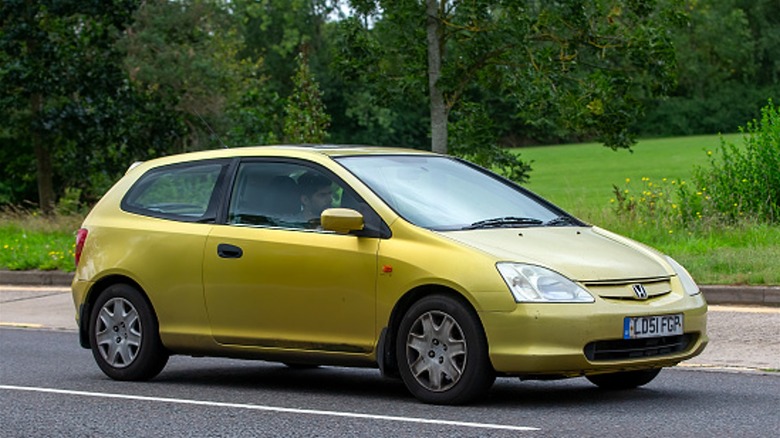Honda Civic: The Best Years To Buy (And The Ones You Should Steer Clear Of)
The early 1970s brought about significant turmoil in the automobile industry, with the Clean Air Act forcing manufacturers to modify their large engines or risk failing emissions standards. Engines and cars up to this point were big and not particularly concerned with efficiency. Just before the oil crises began, which would further focus the public's attention on vehicle efficiency, a compact Japanese economy car called the Honda Civic entered the scene in 1972.
Now, with over five decades under its belt, the Honda Civic continues to succeed, with large numbers of buyers eager to own one. According to Motor1.com, Honda sold a total of 200,381 Civic's in 2023. The strong sales numbers may be due to the fact that the 2023 Honda Civic offers features that will change the way you use your car. Overall, the Civic has furthered automotive technology and innovation with some truly impressive production years. However, not every Civic is created equal, and there are definitely some models to avoid if you're looking to add value to your collection.
Determining the best and worst iterations from more than 50 years of production is challenging. However, examining sales numbers, customer complaints, and feature enhancements should help to narrow down the top and bottom choices.
The best Honda Civic years
The latter half of the first generation saw significant improvements on the original 1972 release. These enhancements included more horsepower, a more robust front bumper, and, in 1977, a Compound Vortex Controlled Combustion engine. Instead of using additional components in the exhaust system to meet stricter emission standards like American automakers, Honda developed a more efficient engine that ran cleaner. The Civic brought in customers and sold more than 100,000 cars in 1977.
A little over twenty years later, right before the turn of the century, Honda came out with their 1999 Civic Si Coup, fondly remembered for its energetic pep. With a 1.6L engine, sporty suspension, and 5-speed manual transmission, this car was fun to drive and easy to handle. This model has since become popular for aftermarket upgrades with its lightweight, straightforward platform and available B16 engine that became a tuner favorite.
Jump forward to the 2014 Honda Civic, and you'll notice it has the lowest number of customer complaints compared to nearly every model that came before it in the 2000s and offers some other tangible benefits. Owners of the 2014 Civic report good fuel economy and reliable performance. The Civic also received safety awards following crash tests and was praised for its daytime running lights and anti-lock braking system. Honda sold almost 326,000 units in 2014.
With total Civic sales in the U.S. reaching over 377,000 in 2017, this production year brought some exciting changes that caught the public's eye. Turbocharged engines facilitated more than ample performance power for a responsive experience behind the wheel. The 2017 Honda Civic was rated five stars by 64% of owners on Edmunds.com.
These Honda Civic years aren't worth it
After the high point of the late 90s with the Honda Civic Si, 2001s Civic saw the most significant complaints and is considered possibly its worst year. From reported transmission issues to pricy repair costs, Honda received over 1,200 complaints. Add in twelve recalls, many of which concerned the airbag system, and you have one of the least-liked iterations of the Civic.
The mid-2000s were also a challenging time for the iconic Honda, as it again was subjected to upwards of 15 recalls. While it was still a thrill behind the wheel, the 2007 Honda Civic suffered issues like engine block cracking, low-quality paint that could exhibit peeling, and excessive travel noise inside the cabin.
Following the high level of complaints in 2006, the 2007 Civic did a bit better but still received over 760 complaints from customers. Consumer Reports points to problems with the exterior paint, molding that wasn't fitted tightly, and the quick development of corrosion.
Jump ahead to the 2016 Honda Civic, and fortunately, it didn't have an issue with excessive recalls like the 2006 iteration. However, it did receive a spike of complaints in an otherwise smooth period for Honda. With reports between 450 and 600 complaints, this year might be one to avoid. Reports of the climate control system malfunctioning and bumpy rides due to more pronounced vibration made drivers unhappy with this release. The 2.0L engine, in particular, suffered from instances where engine components weren't installed at all or fitted improperly, causing cascading problems, including internal damage.


